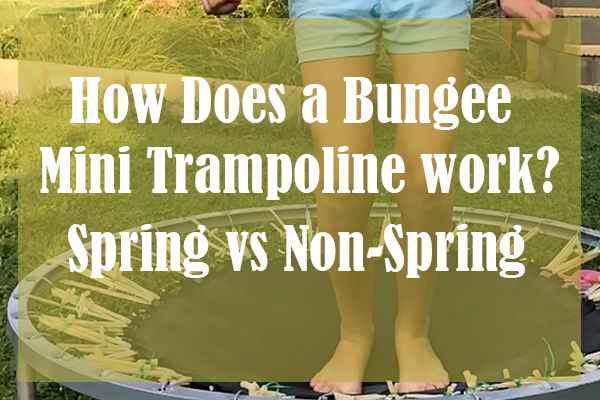
How Does a Bungee Mini Trampoline Work? Spring vs Non-Spring
We are certain that by now you’re aware of the benefits of rebounding as a form of exercise. To quickly brief you through the benefits — rebounding is a great way to strengthen your cardiovascular system, immune system, and hormonal system. It is also a scientifically proven way of losing weight and developing a stronger mental state.
Now that you’re ready to start your rebounding routine, the first step is to purchase a good mini trampoline. Please note that these trampolines are not the same as the ones you find in kids’ toy stores. These trampolines are hardy and exercise-friendly. The best part is that children can use them too.
What’s more is that, nowadays, trampolines come with net enclosures. In the past, there was no such thing. Owing to the increasing injuries caused by falling out of the trampoline, manufacturers started building a net around the trampoline. So this net provides extra safety for the user.
A Few Things to Note

When you’re looking to purchase a mini trampoline, you might come across the word rebounder a lot. Ideally, mini trampolines are what kids use to have fun. Rebounders, on the other hand, are used by adults for exercising. Nowadays, these two words are used interchangeably because of how close they are in their function. The only thing you need to keep in mind is that you shouldn’t purchase a mini trampoline for rebounding from a toy store.
Another thing you will notice is that there are two types of mini trampolines. You have a mini trampoline with springs and a mini trampoline without springs.
In this article, we will share everything you need to know — how a mini trampoline with springs and a mini trampoline without springs work, spring vs. bungee rebounder and finally, we will also advise you on which one is the best buy for you.
How does a Spring Rebounder Work?

The rim of the spring rebounder is tied to its mat with steel springs. The best mini trampoline with springs comes with tapered steel springs and a padded cover over the springs.
This type of trampoline provides a firm bounce so you can try more than just jumping on them. By this, we mean you can try jogging and hopping. However, pay close attention to the quality of your seller’s products because most mini trampolines with springs can have outdated builds. The technology in these trampolines is obviously older than the more modern ones. So they can set limits to your exercise routine. In worse cases, they can result in health problems which we will discuss shortly.
However, the firmness in mini trampolines with springs provides less elasticity. So if you’re, say, over 50, this would be a great option for you. It is also more affordable than most other trampolines.
How does a No-Spring Trampoline Work?

The other type of rebounders is a mini trampoline without springs or the rebounder bungee trampoline. Unlike in a mini trampoline with springs, the trampoline mat is connected to the rim with firm yet flexible cords.
The increased elasticity in a springless rebounder provides a greater bounce which supports the joints and ligaments of your body. At the same time, the extra bounce gets your muscles to work harder and can burn a lot of calories as well.
Moreover, if you’re someone who can’t tolerate annoying squeaks and sounds, the springless rebounder is more quiet and firm than most other rebounders. It’s also a great way to get your mind off of things. Thus, a mini trampoline without springs can actually do a better job at improving mental health than a mini trampoline with springs.
Our Rebounder Recommendations | Our Rating | Images (click for more) |
|---|---|---|
94 | ||
93 | ||
90 |
Band Trampoline vs. Spring

Now that you have an idea about the two kinds of trampolines, let’s delve into their differences.
Mini trampolines with springs are great. But did you know that a frustrated father who wanted to provide his children with a safer way of using the trampoline invented the springless trampoline? He was right. Mini trampolines with springs can actually cause more damage than mini trampolines without springs.
It is true. Rebounders are great. They’re easy to use and very convenient. But they can also be very risky if you don't use them wisely. For this reason, we advise beginners to take it easy. When compared with a springless rebounder, a spring rebounder provides a more firm bounce. But it doesn’t absorb the impact of the bounce. A springless rebounder, on the other hand, does absorb the impact. Because of this, it has caused fewer injuries and bone fractures than a spring rebounder.
However, don’t let the risk-factor discourage you from rebounding altogether. After all, any workout has potential risks associated. It is up to you to take necessary precautionary measures.
The other problem associated with spring rebounders is that the springs can corrode. Eventually, you might have to get rid of the trampoline because using one that has rusted springs can be very dangerous. Obviously, this wouldn’t be the case if you purchase a high-quality mini trampoline with springs. That is what we recommend.
The springs can also cause cuts or similar injuries which is another reason why a springless rebounder is usually the preferred choice. In fact, if you have kids, they are sure to enjoy rebounding once the trampoline comes in. So, we advise you to opt for a springless one because that could save them from hurting their toes or cutting themselves.
A springless rebounder does not have such a problem. Maintaining one isn’t as troublesome as maintaining a spring rebounder. Yet, maintaining a mini trampoline without springs isn’t a piece of cake either. We say this because the bungee cords could wear away after some time too. Eventually, they will require replacement as well.
However, spring rebounders are not all disadvantageous. Not everyone can afford an expensive trampoline. If you’re one of them, then a spring rebounder is a better choice because it is always cheaper than a springless one.
Further, if you want to work out just to remain healthy, a spring rebounder would be a smarter alternative. You can jog and hop on it as well. The bungee rebounder is not built for this kind of activity. People usually use it to build muscles or for heavy workout training.
The best part about rebounding is its convenience. With spring rebounders, you won’t even need special shoes to wear before your workout. If you have never been trained in the past, we suggest that you start by wearing special shoes to prevent hurting your foot. But eventually, you’ll be able to rebound without any of that.
Buying Advice
Finally, to give you our last words on which trampoline you should go for. Before you purchase any trampoline, there are some things you need to keep in mind. Don’t get scammed by lower prices. In the spring vs. bungee rebounder battle, the spring rebounder wins when it comes to the cost.
However, many sellers may try to trick you into purchasing a cheap, low-quality spring trampoline. The offer may be very attractive but we have already discussed the risks associated with cheap springs.
Further, if you are inclined towards a mini trampoline with springs, try to make sure that the springs are covered with pads. Doing this is the best way to prevent possible injuries caused by falling on the metal springs.
If you remember, at the very beginning of this article we told you about the net enclosure around trampolines. If you’re in your 30s or 40s, you might overlook this or deem it unnecessary because you probably didn’t have this during your time. However, it is essential that you purchase a trampoline with this net enclosure. The best would be a rebounder with a flexible netting enclosure.
One other thing we advise you to pay attention to is the quality of the mat. Quite often, this is something buyers forget to look into. The best is one that has extreme resistance to stretching. Nylon and plastic mats are definitely a bad idea as they stretch over time and can result in a twisted ankle or foot.
We have already elaborated on the spring vs. bungee rebounder debate. Clearly, rebounder bungee trampolines have more pros than mini rebounders with springs. Here’s an easy way to decide. If you’re a beginner and you can’t afford to invest in expensive equipment yet, a spring rebounder would be a great choice for you. Just don’t postpone your workout by telling yourself that you will save up and purchase a mini trampoline without springs. What matters is that you start working out as soon as possible.
If you’ve already had training and you can afford to spend a bit more now, a rebounder bungee trampoline would be perfect for you.
Overall, although a springless rebounder is more expensive, it sure has more health benefits than a spring rebounder.
We hope this article helped you decide whether you want a mini trampoline with springs or a mini trampoline without springs. If you’ve got more to say, do drop your comments below. Also, now that you’ve benefited from it, share this article with all your friends too. That way you can encourage them and start a rebounding routine together, making it more fun!
Our Rebounder Recommendations | Our Rating | Images (click for more) |
|---|---|---|
94 | ||
93 | ||
90 |




